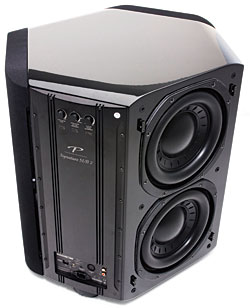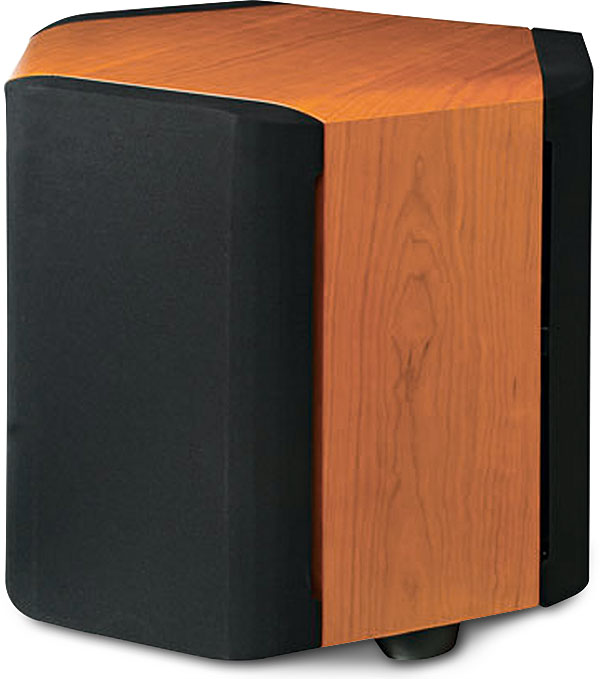Paradigm Reference Signature SUB 2 Subwoofer
 Price: $9,000 At A Glance: Room- and house-threatening LFE bass for movies • Surprising rhythm, pacing, and articulation for music • Relatively small footprint for a behemoth sub
Price: $9,000 At A Glance: Room- and house-threatening LFE bass for movies • Surprising rhythm, pacing, and articulation for music • Relatively small footprint for a behemoth sub
Because You Can
 So, I’m wheeling this ginormous 230-pound Paradigm subwoofer down and around the side of my house, to the double-door, daylight basement that serves as my home theater room. Being impatient, I’m doing this by myself and hoping like hell I don’t tip the thing over and watch it roll end over end down the slope in my backyard. About this time, it occurs to me to wonder, “Why am I even reviewing something this big?” The answer that came to mind is probably the same reason people will buy this $9,000 powder keg of bass. Because I can.
So, I’m wheeling this ginormous 230-pound Paradigm subwoofer down and around the side of my house, to the double-door, daylight basement that serves as my home theater room. Being impatient, I’m doing this by myself and hoping like hell I don’t tip the thing over and watch it roll end over end down the slope in my backyard. About this time, it occurs to me to wonder, “Why am I even reviewing something this big?” The answer that came to mind is probably the same reason people will buy this $9,000 powder keg of bass. Because I can.
Of course, there’s more to it than that. At CES 2010, the best home theater demo I saw and heard was in the Anthem room, with Anthem’s electronics and sister brand Paradigm’s speakers and subwoofers. The bass was sensational, thunderous, and room shaking, and yet it was strikingly refined. That was the first time I saw the SUB 2, a 4,500-watt subwoofer (rated RMS, and never mind if you can actually get that out of your wall), with six 10-inch woofers arrayed in pairs, firing out of three sides of the cabinet. You read that right. I was every bit as awestruck as you probably are now. Why would Paradigm design and build such a thing? Because they can. In home theater and in life, it’s my firm belief that anything worth doing is worth overdoing. If that’s your philosophy too, read on, because the SUB 2 is a helluva ride.
Powerhouse and Polish
I already threw out some impressive numbers, but there’s more to this sub than that. The driver cones are mineral-filled polypropylene, with motor/magnet structures that weigh 25 pounds each. That’s over 150 pounds in the drivers alone, if you’re keeping score at home. The three pairs of drivers fire out of three separate sides of the unusual hexagonal-shaped, sealed cabinet in what Paradigm calls Vibration-Canceling Design Architecture. The opposing forces of the drivers in this alignment cancel each other out, so the cabinet doesn’t vibrate or walk around on its own. No matter how hard the sub is cranking along, you hear the sub and not its cabinet singing along or rocking back and forth. For a super-sub with six drivers, the in-room footprint is smaller than you’d think, measuring right around 24 inches in all three dimensions. That’s not dainty by any stretch, but frankly, it sounds like it’s a lot bigger.

The electronics are every bit as impressive as the mechanical elements. The amplification is efficient, Power Factor Corrected Class D with integrated DPS processing for signal shaping and distortion reduction. About that ludicrous power rating, the guys at Paradigm—with straight faces, I might add—claim the SUB 2 can deliver 4,500 watts (9,000 watts peak), but only if you and your electrician hook that sucker up to 240-volt service. I don’t have an electrician on call, so I had to live with a measly 3,000 watts (rated) continuous with my sissy-pants 120-volt service. Again, I’ll leave it to others to debate whether that much power can get out of my or anyone else’s walls to the sub, but here’s my tease on that: What I heard with my 120-volt service left me scared shitless to hear what this thing would sound like with 240 volts.
On the back panel, there are dual RCA inputs, one balanced/XLR input, and a USB connector for the Paradigm Perfect Bass Kit, which I’ll map out later. There’s also an Auto On selector, which turns the SUB 2 on when it detects an input signal, plus adjustments for Level (volume), Subwoofer Cut-off Frequency, and Sub/Sat Phase alignment. I ran it with Paradigm’s Perfect Bass Kit and left all three controls at high noon.
Perfect Bass?
Perhaps the SUB 2’s most impressive feature is its inclusion of the Perfect Bass Kit. The PBK is essentially a stripped-down version of the heralded Anthem Room Correction system that works only in the low frequencies. The SUB 2 ships with a substantial microphone, as well as the PBK software and unique microphone calibration files on a disc (the software is tailored to the response of each individual microphone for accuracy).
You load and then run the PBK software on a PC and connect both the microphone and the SUB 2 to the PC via USB. The PC sends test tones to the SUB 2, and you measure in at least five different in-room positions. The PBK evens out the SUB 2’s in-room response, flattening both peaks and dips.
What if your AVR or surround processor already has a room-correction system? Paradigm recommends that you use the PBK with the SUB 2 first and then run the other room correction, which should theoretically see flat bass response and leave the low frequencies alone. I’m using Anthem’s D2v surround processor, which uses Anthem Room Correction. Paradigm’s recommended procedure worked well, and the ARC graphs confirmed that no extra EQ was applied to the SUB 2.
- Log in or register to post comments























































